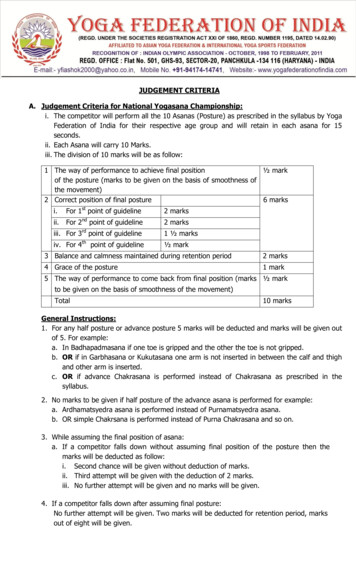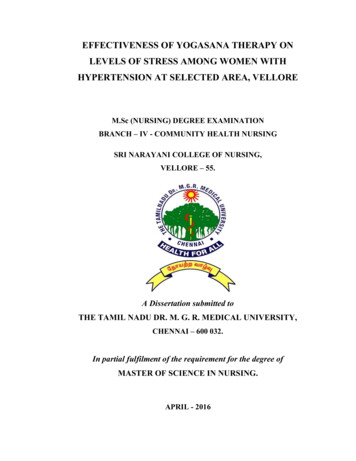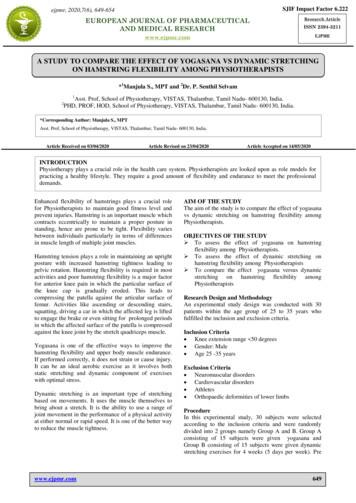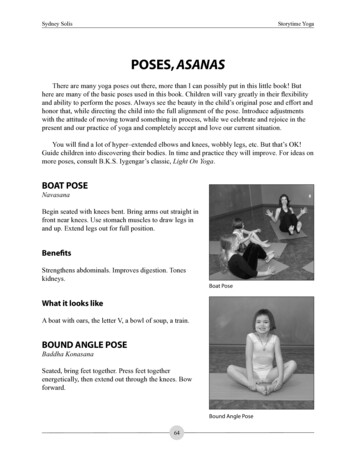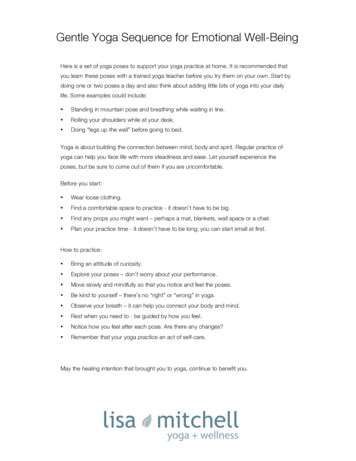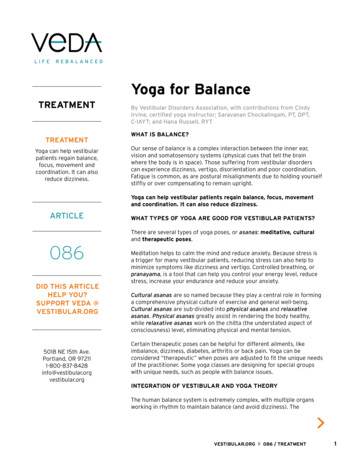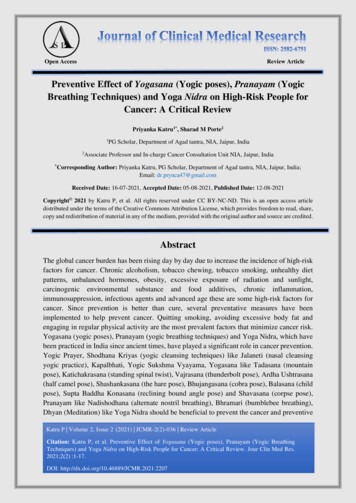
Transcription
Open AccessReview ArticlePreventive Effect of Yogasana (Yogic poses), Pranayam (YogicBreathing Techniques) and Yoga Nidra on High-Risk People forCancer: A Critical ReviewPriyanka Katru1*, Sharad M Porte21PG Scholar, Department of Agad tantra, NIA, Jaipur, India2Associate Professor and In-charge Cancer Consultation Unit NIA, Jaipur, India*Corresponding Author: Priyanka Katru, PG Scholar, Department of Agad tantra, NIA, Jaipur, India;Email: dr.prynca47@gmail.comReceived Date: 16-07-2021, Accepted Date: 05-08-2021, Published Date: 12-08-2021Copyright 2021 by Katru P, et al. All rights reserved under CC BY-NC-ND. This is an open access articledistributed under the terms of the Creative Commons Attribution License, which provides freedom to read, share,copy and redistribution of material in any of the medium, provided with the original author and source are credited.AbstractThe global cancer burden has been rising day by day due to increase the incidence of high-riskfactors for cancer. Chronic alcoholism, tobacco chewing, tobacco smoking, unhealthy dietpatterns, unbalanced hormones, obesity, excessive exposure of radiation and sunlight,carcinogenic environmental substance and food additives, chronic inflammation,immunosuppression, infectious agents and advanced age these are some high-risk factors forcancer. Since prevention is better than cure, several preventative measures have beenimplemented to help prevent cancer. Quitting smoking, avoiding excessive body fat andengaging in regular physical activity are the most prevalent factors that minimize cancer risk.Yogasana (yogic poses), Pranayam (yogic breathing techniques) and Yoga Nidra, which havebeen practiced in India since ancient times, have played a significant role in cancer prevention.Yogic Prayer, Shodhana Kriyas (yogic cleansing techniques) like Jalaneti (nasal cleansingyogic practice), Kapalbhati, Yogic Sukshma Vyayama, Yogasana like Tadasana (mountainpose), Katichakrasana (standing spinal twist), Vajrasana (thunderbolt pose), Ardha Ushtrasana(half camel pose), Shashankasana (the hare pose), Bhujangasana (cobra pose), Balasana (childpose), Supta Baddha Konasana (reclining bound angle pose) and Shavasana (corpse pose),Pranayam like Nadishodhana (alternate nostril breathing), Bhramari (bumblebee breathing),Dhyan (Meditation) like Yoga Nidra should be beneficial to prevent the cancer and preventiveKatru P Volume 2, Issue 2 (2021) JCMR-2(2)-036 Review ArticleCitation: Katru P, et al. Preventive Effect of Yogasana (Yogic poses), Pranayam (Yogic BreathingTechniques) and Yoga Nidra on High-Risk People for Cancer: A Critical Review. Jour Clin Med Res.2021;2(2) :1-17.DOI: http://dx.doi.org/10.46889/JCMR.2021.2207
2management. Thus, Yogasana, Pranayam and Yoga Nidra can help to prevent cancer byfacilitating in the discontinuation of tobacco use, the withdrawal of alcohol and opioid use, thereduction of obesity, the maintenance of a healthy oxygen level in the breathing, the reductionof oxidative stress that causes cancer and the prevention of onco-genetic mutation in cancerprone individuals. However, further scientific data is required.KeywordsYogasana (Yogic Poses); Pranayam (Yogic Breathing Techniques); Yoga Nidra; Prevention;CancerIntroductionChronic alcoholism, tobacco chewing, tobacco smoking, unhealthy diet patterns, unbalancedhormones, obesity, excessive exposure of radiation and sunlight, carcinogenic environmentalsubstance and food additives, chronic inflammation, immunosuppression, infectious agents andold age these are some high-risk factors for cancers [1]. Drinking alcohol can increase risk ofcancer of the mouth, throat, esophagus, larynx (voice box), liverand breast [2]. Tobacco usecauses many types of cancer, including cancer of the lung, larynx (voice box), mouth,esophagus, throat, bladder, kidney, liver, stomach, pancreas, colon and rectum and cervix, aswell as acute myeloid leukemia [3].Environmental Carcinogens such as Aflatoxins, Aristolochic Acids, Arsenic, Asbestos,Benzene, Benzidine, Beryllium, 1,3-Butadiene, Cadmium, Coal Tar and Coal-Tar Pitch, CokeOven Emissions, Crystalline Silica (respirable size), Erionite Ethylene Oxide, Formaldehyde,Hexavalent Chromium Compounds, Indoor Emissions from the Household Combustion ofCoal Mineral Oils: Untreated and Mildly Treated Nickel Compounds, Radon, Second-handTobacco Smoke (Environmental Tobacco Smoke), Soot, Strong Inorganic Acid, MistsContaining Sulfuric Acid, Thorium, Trichloroethylene, Vinyl Chloride, Wood Dust, increasedthe Cancer Risk [4].People with chronic inflammatory bowel diseases, such as ulcerative colitis and Crohn disease,have an increased risk of colon cancer [5]. People who are obese may have an increased riskof several types of cancer, including cancers of the breast (in women who have been throughmenopause), colon, rectum, endometrium (lining of the uterus), esophagus, kidney, pancreasand gallbladder [6]. Scientists have studied many additives, nutrients and other dietarycomponents for possible associations with cancer risk. The sun, sunlamps and tanning boothsall give off Ultraviolet (UV) radiation. Exposure to UV radiation causes early aging of the skinand damage that can lead to skin cancer.Katru P Volume 2, Issue 2 (2021) JCMR-2(2)-036 Review ArticleCitation: Katru P, et al. Preventive Effect of Yogasana (Yogic poses), Pranayam (Yogic BreathingTechniques) and Yoga Nidra on High-Risk People for Cancer: A Critical Review. Jour Clin Med Res.2021;2(2) :1-17.DOI: http://dx.doi.org/10.46889/JCMR.2021.2207
3The global cancer burden has risen to 19.3 million cases and 10 million cancer deaths in 2020[7]. As a result, it is important to prevent cancer before it progresses to the point when it isdifficult to save mankind from this catastrophe.The purpose of the Ayurveda science is to preserve the health of the healthy and cure thedisease of the unhealthy [8]. Yogasana is beneficial in the management of prevention of Cancerand many Yogasana like Surya Namaskar (Sun salutations), Tadasana (mountain pose),Ushtrasana, Vakrasana (twisted pose), Gomukhasana (cow face yoga pose), Bhujangasana,Shalabhasana (Locust pose), Dhanurasana (bow pose), Simhasana (lion pose), Shavasana hasrecommended by Ministry of AYUSH, Govt. of India [9]. Pranayam is the conscious awarenessof breath and it refers to breathing exercises that remove physical and mental impediments inour bodies with the breath. Pranayam has been shown to considerably reduce oxidative stress,such as free radicals and lipid peroxidation products, as well as significantly raise the level ofantioxidant enzymes. Pranayam not only reduces oxidative stress but also enhances anindividual's antioxidant level [10]. This Research Paper will focus on the critical discussion ofthe Preventive Effect of Yogasana, Pranayam and Meditation on High-Risk People for Cancer.AimTo critically examine and debate the preventive effects of Yogasana, Pranayam and Yoga Nidraon high-risk people with cancer.Objectives1. To evaluate, elaborate the role of Yogasana, Pranayam and Yoga Nidra for high-risk peopleof cancer2. To provide the protocol of Yogasana, Panayam and Yoga Nidra for high-risk people ofcancerMaterial and MethodThis research paper is based on the critical review of preventive effect Yogasana, Pranayamand Yoga Nidra on high-risk people of cancer. Yoga Literature has been collected fromGuidelines and Training Manual on Integration of AYUSH (Ayurveda) With National Programfor Prevention and Control of Cancer, Diabetes, Cardiovascular Diseases and Stroke(NPCDCS), Official Guidebook for Yoga Professionals by AYUSH Ministry, Yoga Protocol,Yogic Practices for Management of Cancer, Pantanjali’s Yoga Sutra and other related text bookKatru P Volume 2, Issue 2 (2021) JCMR-2(2)-036 Review ArticleCitation: Katru P, et al. Preventive Effect of Yogasana (Yogic poses), Pranayam (Yogic BreathingTechniques) and Yoga Nidra on High-Risk People for Cancer: A Critical Review. Jour Clin Med Res.2021;2(2) :1-17.DOI: http://dx.doi.org/10.46889/JCMR.2021.2207
4of Yoga. The Text Book of Modern Medicine related to high-risk people for cancer has beenreviewed. The concern Research papers on application of Yogasana, Pranayam and Meditationabout prevention of cancer has been also referred.The Historic Outlook of YogaYoga was first known in India as early as 5000 B.C. according to archaeological evidenceHistorical proof of the existence of Yoga can be found in the pre-Vedic period. The mainsources from which we acquire information on Yoga practices and related literature throughoutthis period are the Vedas, Puranas, Upanishads, Smritis, Buddhism, Jainism, Panini and Epics.The concept of yoga has been found at first in Rigveda. Though Yoga was being practiced inthe pre-Vedic period, the great Sage Maharshi Patanjali systematized and codified the existingpractices of Yoga, in his famous text ‘Yoga Sutras’ and introduced ‘Ashtang Yoga’. The NathaYogis of Hathayoga tradition like Matsyendaranatha, Gorkshanatha, Swatmaram, Gheranda,Shrinivasa Bhatt are some of the great personalities who popularized the Hatha Yoga practicesduring this period. The Saptanga-yoga of Gheranda Samhita, Shadanga-yoga ofGorakshashatakam, Chaturanga-yoga of Hathayogapradipika, have played the major role todevelop the Hatha-yoga. Now in the contemporary time, everybody has conviction about yogapractices towards the preservation, maintenance and promotion of health and Yoga, whichpracticed and taught in India, entered the Western world in 19th century with the translation ofbasic yogic texts [11,12].These different philosophies, traditions, lineages and Guru-shishya paramparas of Yoga leadto the emergence of different traditional schools of Yoga. However, the widely practiced YogaSadhanas are Yama (social ethics), Niyama (personal practices), Asana (postures), Pranayam,Pratyahara (turning inward), Dharana (concentration), Dhyana (Meditation),Samadhi/Samyama (Pure bliss), Bandhas (Locking techniques) and Mudras (symbolicgestures) and Shat-karmas. Yama's are restraints and Niyama's are observances. Asanas areused for capable of bringing about stability of body and mind. Pranayam popularly known asYogic breathing consists in developing awareness of breathing followed by wilful regulationof respiration. Pratyhara indicates dissociation of consciousness from the sense organs.Dharana indicates on body and mind internally. Dhyana means Meditation is a practice whichhelps in concentration of the body and mind, while Samadhi means integration. Bandhas andMudras are practices associated with Pranayam, while Shat-karmas are de-toxificationprocedures, help to remove the toxins accumulated in the body [13].‘Yoga-chitta-vritti-nirodhah’ means Yoga is the process by which the state of mind or state ofthoughts should completely confining [14]. The term ‘Yoga’ is derived from the Sanskrit words‘YUJ’, meaning ‘to join’ or ‘to unite’. As per Yogic scriptures the practice of Yoga leads tothe union of individual consciousness with that of the Universal Consciousness, indicating aKatru P Volume 2, Issue 2 (2021) JCMR-2(2)-036 Review ArticleCitation: Katru P, et al. Preventive Effect of Yogasana (Yogic poses), Pranayam (Yogic BreathingTechniques) and Yoga Nidra on High-Risk People for Cancer: A Critical Review. Jour Clin Med Res.2021;2(2) :1-17.DOI: http://dx.doi.org/10.46889/JCMR.2021.2207
5perfect harmony between the mind and body. Yoga is one of the most powerful druglesssystems of treatment. It is having its own concept of wellness which has been scientificallyunderstood and presented by many. Yoga can be adopted as lifestyle for promoting our physicaland mental health [15].Yoga is not only form of physical exercise, but it ensures mental health and physical fitness.By doing physical exercises, one can develop only body muscles. But through Yoga, oneachieves the conditioning of even all the internal organs like - heart, brain, spleen, liver, lungs,intestines and all the glands, like - thyroid, pituitary and penial gland of the brain, functionbetter. Through meditation, breathing exercises (called Pranayams); One can get rid of all stressand live a healthy life [16].High Risk Factor-People of CancerCancer-causing compounds are found in several smokeless tobacco products. When the levelsof these carcinogens are higher, the risk of cancer increases. Tobacco smoke contains a varietyof compounds that are hazardous to both smokers and non-smokers. At least 69 of the 250known toxic compounds in tobacco smoke can cause cancer (Table 1 and 2) [18]. Ethyl alcohol,commonly known as alcohol, is a proven carcinogen that raises the risk of cancers such asbreast, liver, mouth, throat, oesophagus and intestine. Heavy drinking may also increase therisk of stomach cancer [19]. Quid chewing has been identified as a separate risk factor for oralcancer. The causal relationship between chewing quid and cancer has been revealed [20].Opium users have a significantly higher risk of developing cancers in different organs of therespiratory, digestive and urinary systems and the CNS [21]. Occupational exposures inpainters are usually associated with the risk of lung cancer [22]. Asbestos is a naturallyoccurring mineral and carcinogen and long-term exposure to Asbestos dust may result inRespiratory Tract Cancer. Asbestos exposure raises the risk of lung cancer, mesothelioma,laryngeal and ovarian cancer and pulmonary fibrosis [23].Quitting smoking, reducing extra body fat and engaging in regular physical activity are themost common factors that minimize cancer risk (Fig. 1).Katru P Volume 2, Issue 2 (2021) JCMR-2(2)-036 Review ArticleCitation: Katru P, et al. Preventive Effect of Yogasana (Yogic poses), Pranayam (Yogic BreathingTechniques) and Yoga Nidra on High-Risk People for Cancer: A Critical Review. Jour Clin Med Res.2021;2(2) :1-17.DOI: http://dx.doi.org/10.46889/JCMR.2021.2207
6S. No.123456789High Risk Factor / PeopleAlcoholic beverages, Betel quid with tobacco, Humanpapillomavirus type 16, Smokeless tobacco, TobaccosmokingIsopropyl alcohol manufacture using strong acids,Leather dust Nickel compounds, Radium-226 and itsdecay products Radium-228 and its decay products,Tobacco smoking Wood dustEpstein–Barr virus, Formaldehyde Salted fish, Chinesestyle Wood dustAcid mists, strong inorganic, Alcoholic beverages,Asbestos (all forms) consumption of Opium, TobaccosmokingAsbestos (all forms), Erionite, Fluoro-edenite, fibrousamphibole, occupational exposure as PainterAcheson process (occupational exposure), Aluminumproduction, Arsenic and inorganic arsenic compounds,Asbestos (all forms), Beryllium and berylliumcompounds, Bis(chloromethyl)ether; chloromethylmethyl ether (technical grade), Cadmium and cadmiumcompounds, Chromium (VI) compounds, Coal, indooremissions from household combustion, Coal gasification,Coal-tar pitch, Coke production, Diesel engine exhausts,Gamma-radiation, Hematite mining (underground), Ironand steel founding, MOPP (vincristine-prednisonenitrogen mustard-procarbazine mixture), Nickelcompounds, Opium, Outdoor air pollution, particulatematter in Paint, Plutonium, Radon-222 and its decayproducts, Rubber manufacturing industry Silica dust,crystalline Soot, Sulfur, mustard, Tobacco smoke, secondhand Welding fumes, X-radiation.Acetaldehyde associated with consumption of alcoholicbeverages, Betel quid with tobacco, Betel quid withouttobacco, Smokeless tobacco, Tobacco smoking, Xradiation, gamma-radiationHelicobacter pylori , Rubber manufacturing industry,Tobacco smoking, X-radiation, gamma-radiationAflatoxins, Alcoholic beverages, Estrogen–progestogencontraceptives, Hepatitis B virus, Hepatitis C virus,Organ SiteOral cavity, PharynxNasal cavity andparanasal sinusNasopharynxLarynxPleura or peritoneumLungOesophagusStomachLiver (hepatocellularcarcinoma)Katru P Volume 2, Issue 2 (2021) JCMR-2(2)-036 Review ArticleCitation: Katru P, et al. Preventive Effect of Yogasana (Yogic poses), Pranayam (Yogic BreathingTechniques) and Yoga Nidra on High-Risk People for Cancer: A Critical Review. Jour Clin Med Res.2021;2(2) :1-17.DOI: http://dx.doi.org/10.46889/JCMR.2021.2207
7101112131416171819202122232425Plutonium Thorium-232 and its decay products, Tobaccosmoking (in smokers and in smokers’ children)Vinyl chlorideThorium-232 and its decay products1,2-Dichloropropane, Clonorchis sinensis, OpisthorchisviverrineSmokeless tobacco, Tobacco smokingAlcoholic beverages, consumption of Processed meat,Tobacco smoking X-radiation, gamma-radiationHuman immunodeficiency virus type 1, Humanpapillomavirus type 16Estrogen menopausal therapy, Estrogen–progestogenmenopausal therapy TamoxifenDiethylstilbestrol (exposure in utero), Estrogen–progestogen contraceptives, Human immunodeficiencyvirus type 1, Human papillomavirus, Tobacco smokingDiethylstilbestrol (exposure in utero), Humanpapillomavirus type 16Asbestos (all forms), Estrogen menopausal therapy,Tobacco smokingAlcoholic beverages, Diethylstilbestrol, Estrogen–progestogen contraceptives, Estrogen–progestogenmenopausal therapy, X-radiation, gamma-radiationTobacco smoking, Trichloroethylene X-radiation,gamma-radiationAristolochic acid, plants containing Phenacetin, analgesicmixtures containing Tobacco smokingAluminum production, 4-Aminobiphenyl Arsenic, andinorganic arsenic compounds, Auramine production,Benzidine, Chlornaphazine, Cyclophosphamide Magentaproduction, 2-Naphthylamine, consumption of Opium,occupational exposure as Painter, Rubber manufacturingindustry, Schistosoma haematobium, Tobacco smoking,ortho-Toluidine X-radiation, gamma-radiationAzathioprine Benzene, Busulfan, 1,3-Butadiene,Chlorambucil Cyclophosphamide, Cyclosporine,Epstein–Barr virus, Etoposide with cisplatin andbleomycin Fission products, including strontium-90,Formaldehyde, Helicobacter pylori, Hepatitis C virus,Liver (angiosarcoma)Gall bladderBiliary tractPancreasesColon and rectumAnusCorpus uteri(endometrium)Uterine cervixVaginaOvaryBreastKidneyRenal pelvis andureterUrinary bladderLeukaemia/lymphomaKatru P Volume 2, Issue 2 (2021) JCMR-2(2)-036 Review ArticleCitation: Katru P, et al. Preventive Effect of Yogasana (Yogic poses), Pranayam (Yogic BreathingTechniques) and Yoga Nidra on High-Risk People for Cancer: A Critical Review. Jour Clin Med Res.2021;2(2) :1-17.DOI: http://dx.doi.org/10.46889/JCMR.2021.2207
826S. No.1234567Human immunodeficiency virus type 1, Human T-celllymphotropic virus type 1, Kaposi sarcoma, herpesvirus,Lindane Melphalan, MOPP (vincristine-prednisonenitrogen mustard-procarbazine mixture),Pentachlorophenol Phosphorus-32, as phosphate Rubbermanufacturing industry,y Semustine [1-(2-Chloroethyl)3-(4- methylcyclohexyl)-1-nitrosourea, or methylCCNU], Thiotepa Thorium-232 and its decay products,Tobacco smoking, Treosulfan X-radiation, gammaradiationPolychlorinated biphenyls Solar radiation UltravioletSkin (melanoma)emitting tanning devicesTable 1: High risk factor / people of cancer by organ site [17].Organ Site InvolvedOral cavity, Pharynx, Uterine cervix,Larynx, Lung, Urinary bladderStomachThyroid, Liver (hepatocellularcarcinoma), Gall bladder, OvaryPancreases, KidneyFactor which Reduces the CancerQuitting smokingQuitting smoking, Absence of excessivebody fat (gastric cardia)Absence of excessive body fatAbsence of excessive body fat, QuittingsmokingOesophagusAbsence of excessive body fat(adenocarcinoma), Quitting smoking(squamous cell carcinoma)Colon and rectumAbsence of excessive body fat, Regularphysical activityBreastAbsence of excessive body fat(postmenopausal), Regular physicalactivityTable 2: Factor which reduces the cancer by organ site.Katru P Volume 2, Issue 2 (2021) JCMR-2(2)-036 Review ArticleCitation: Katru P, et al. Preventive Effect of Yogasana (Yogic poses), Pranayam (Yogic BreathingTechniques) and Yoga Nidra on High-Risk People for Cancer: A Critical Review. Jour Clin Med Res.2021;2(2) :1-17.DOI: http://dx.doi.org/10.46889/JCMR.2021.2207
9Figure 1: Factors that minimize cancer risk.Yoga Protocol useful to prevent the CancerSuryanamaskar and Bhujangasan are helpful in preventing cancer in people who have high riskfactors such as obesity, tobacco use, smokingand asbestos exposure. Except for obesity,Pashchimotasan and Marjari Asana are beneficial in preventing cancer in high risk factors suchas tobacco smoking and asbestos dust. Pawanmuktasana is beneficial in controlling respiratoryvitiation caused by Tobacco Smoke and dust Asbestos, which can help avoid cancer in thefuture. Halasana and Matsendrasana are effective for controlling obesity (fat deposition) anddust-induced respiratory vitiation, both of which can help prevent cancer in the future.Padahastasana, Sarvangasana, Ushtrasana, Drutahalasana, Shashank-Bhujangasana are usefulto avoid obesity, Setubandhasana, Vrikshashana are useful to prevent Tobacco Smoking causedvitiationand Dhanurasana and Ushtrasana are useful to prevent vitiation due to dust such asasbestos. Jala Neti and Kunjal are Shatkarma, which are Yogic practises involving bodypurification to prevent cancer, namely cancer caused by Obesity, Tobacco, Smoking andKatru P Volume 2, Issue 2 (2021) JCMR-2(2)-036 Review ArticleCitation: Katru P, et al. Preventive Effect of Yogasana (Yogic poses), Pranayam (Yogic BreathingTechniques) and Yoga Nidra on High-Risk People for Cancer: A Critical Review. Jour Clin Med Res.2021;2(2) :1-17.DOI: http://dx.doi.org/10.46889/JCMR.2021.2207
10Asbestos dust. To prevent cancer caused by Obesity, Tobacco, Smoking and Asbestos dust,Nadhi-Shodhan and Bhastrika Pranayam should be used. Yoga Shavasan and Yoga Nidra maybe beneficial in reducing stress-related harm (Table 3 and 4) (Fig. 2).S. No.1HighRiskPeopleCommon2ObesityName of Ashtang YogaAsanaShatakriya Pranayam Bandha/Mudra Shithilikaran(Cool down)Suryanamaskar,NadhiApana-VayuYaugikSupta Bandh----------ShodhanMudra andShavasana,konasana, Marjari(alternateMahamudraYoga NidraAsana (cat pose),nostrilSukhasana (easybreathing),pose),BhastrikaViparitkarani (legs(breath ofup the wall pose),fire) andSetubandhasanaBhramari(bridge pose),Virbhadrasana(Warrior pose) andShavasanaSuryanamaskar,Jala Matsendrasan(therapeutic Bhastrika(half fish eated forwardbend),Bhujangasan,Dhanurasan (bowpose), Matsyasan,Halasana (plowpose), Tadasana,Kati- Chakrasana(standing spinaltwist),Padahastasana(hand to footpose),Katru P Volume 2, Issue 2 (2021) JCMR-2(2)-036 Review ArticleCitation: Katru P, et al. Preventive Effect of Yogasana (Yogic poses), Pranayam (Yogic BreathingTechniques) and Yoga Nidra on High-Risk People for Cancer: A Critical Review. Jour Clin Med Res.2021;2(2) :1-17.DOI: http://dx.doi.org/10.46889/JCMR.2021.2207
1134Sarvangasana(shoulder stand),Ushtrasana,Drutahalasana(dynamic ploughpose), ShashankBhujangasanaTobaccoSuryanamaskar,Jala Neti,NadhiPrana Mudra,Smoking PawanmuktasanaShodhan,Mahamudra,(wind relievingBhastrika,Yoga Mudrapose),Bhramariand KhechariPashchimotasan,and thing)Setubandhasana,Marjari Asana,VrikshashanaAsbestosSuryanamaskar,Jala hodhan,Pashchimotasan, Kapal rasana,BhastrikaMarjari AsanaTable 3: Yoga protocol useful to prevent the cancer [24].------------------------Katru P Volume 2, Issue 2 (2021) JCMR-2(2)-036 Review ArticleCitation: Katru P, et al. Preventive Effect of Yogasana (Yogic poses), Pranayam (Yogic BreathingTechniques) and Yoga Nidra on High-Risk People for Cancer: A Critical Review. Jour Clin Med Res.2021;2(2) :1-17.DOI: http://dx.doi.org/10.46889/JCMR.2021.2207
12S. No.12Name ofKriyaYogic PrayerShodhanaKriyasName of PracticeDuration1 min7 minsJalaneti (twice a week) andKapalbhati (3-5 rounds with 15-20 strokes)3YogicSukshmaVyayama (3rounds each)Uchcharana-sthalattha Vishuddh-chakra-shuddhiBuddhi totha a-sthala-shakti-vikasakaGriva Shakthi Vikasaka -1,2, &310 mins4Yogasana15 mins5PranayamTadasana, Katichakrasana, Vajrasana, ArdhaUshtrasana, Shashankasana, Bhujangasana, Balasana,Supta Baddha Konasana and ShavasanaNadishodhana Pranayam (5 rounds)Bhramari Pranayam (3 rounds)5 mins6Dhyan7 mins(Meditation)45 minsTotalDurationTable 4: Yogic practices for prevention and preventive management of cancer [25].Yogic Prayer, Shodhana Kriyas like Jalaneti, Kapalbhati, Yogic Sukshma Vyayama, Yogasanalike Tadasana, Katichakrasana, Vajrasana, Ardha Ushtrasana, Shashankasana, Bhujangasana,Balasana, Supta Baddha Konasana and Shavasana, Pranayam like Nadishodhana, Bhramari,Dhyana like Yoga Nidra should be beneficial to prevent the cancer.Figure 2: Yogic practicing process.Special Hazards Associated with YogaYoga has several unique risks linked with doing poses during Yoga. Falling risk whileperforming upside-down Yoga poses such as Shirshasana or Sarvangasana. Muscle pulling isan ergonomic concern when performing difficult positions with a stiff body, such asKatru P Volume 2, Issue 2 (2021) JCMR-2(2)-036 Review ArticleCitation: Katru P, et al. Preventive Effect of Yogasana (Yogic poses), Pranayam (Yogic BreathingTechniques) and Yoga Nidra on High-Risk People for Cancer: A Critical Review. Jour Clin Med Res.2021;2(2) :1-17.DOI: http://dx.doi.org/10.46889/JCMR.2021.2207
13Paschimottanasana. When performing challenging postures like as Sarvanangsana, there is arisk of neck pain. Severe back pain or a slip disc risk while performing challenging poses suchas Halasana. Sprained ankle when performing some asanas, such as Vajrasana [26].Safety and Precautionary Measures during YogaThe following are some precautions to take when doing yoga. The first and most importantprecaution is to only practice Yoga under the guidance of a professional Yoga Instructor.Before beginning Yoga, seek medical advice, especially if you are over the age of 30. Thebody's flexibility limit should not be exceeded during the push beyond. The harder poses shouldnot be held for extended periods of time during yoga. Yoga should not be attempted shortlyafter eating or drinking anything; instead, let at least 3 to 5 hours after the last meal [27].DiscussionQuitting tobacco smoking for 1-4 years resulted in a head and neck cancer risk reduction, whilea beneficial was only observed after 20 years of quitting of alcohol [28].Chronic stress raises the risk of almost all diseases, including cancer. Meditation, such as YogaNidra, counteracts the effects of stress by creating a relaxation response. During meditation,blood pressure and muscular tension fall in tandem with stress chemicals such as cortisol andadrenaline. Participants reported considerably lower perceived stress at the end of the trial,showing that yoga nidra may be an effective intervention in managing and preventingworkplace stress [29]. Stress is an individual's cognitive or emotional reaction to any situationthat necessitates adjustment. Yoga nidra practice also decreases tension and anxiety [30].The most common factors that minimize cancer risk are the absence of excess body fat andregular physical activity. It means that those who are obese and do not exercise are more likelyto develop cancer in the future. The clinical examination showed that frequent practice of yogaactivities significantly reduces female students' weight and enhances their performance [31].Yoga instruction from a certified yoga instructor is preferable for improving posture and weightloss. Yoga therapy has been shown to increase women's quality of life and reduce body weight[32].Yoga is intended to be a lifelong activity that can potentially reinforce smoking cessation afterformal smoking cessation treatment has ended. It also strengthens the effects of CBT byproviding an alternative means of coping with stress and cigarette cravings and it has beenlinked to improvements in mood and quality of life [33]. The study found that Alternate NostrilBreathing (ANB) reduces the intensity of smoking cravings immediately. It also cleans theKatru P Volume 2, Issue 2 (2021) JCMR-2(2)-036 Review ArticleCitation: Katru P, et al. Preventive Effect of Yogasana (Yogic poses), Pranayam (Yogic BreathingTechniques) and Yoga Nidra on High-Risk People for Cancer: A Critical Review. Jour Clin Med Res.2021;2(2) :1-17.DOI: http://dx.doi.org/10.46889/JCMR.2021.2207
14lungs and improves the Pulmonary Function Test (PFT), as well as reducing smoking cravingsand withdrawal symptoms. It can also help smokers with psychiatric problems who are resistantto medication [34]. Smoking and dust from numerous sources, such as asbestos dust, causerespiratory diseases such as COPD and bronchial asthma, as well as cancer. Yogic practicesare thought to be an excellent exercise for maintaining good health, as well as having aprofound effect on lung functions and the prevention, controland rehabilitation of manyrespiratory disorders. The study found that Pranayam can benefit people with moderate tosevere COPD [35]. Yoga may be an effective adjunct therapy for smoking cessation in women,since participants in the yoga programme reported lower anxiety and improved felt health andwell-being when compared to controls [36]. A meta-analysis found that yoga training canenhance lung function and functional exercise capacity in COPD patients when compared tostandard therapy [37]. According to the findings of the study, four weeks of Yoga practice canhelp reduce depression symptoms and improve quality of life in drug users [38].Yoga was found to be useful in lowering depression and improving quality of life amongalcoholics [39]. A recent study on opioid dependence syndrome reported significantly higherimprovement in mood status and Quality of Life (QoL) in patients in yoga group as comparedto routine hospital
'Yoga-chitta-vritti-nirodhah' means Yoga is the process by which the state of mind or state of thoughts should completely confining [14]. The term 'Yoga' is derived from the Sanskrit words 'YUJ', meaning 'to join' or 'to unite'. As per Yogic scriptures the practice of Yoga leads to
